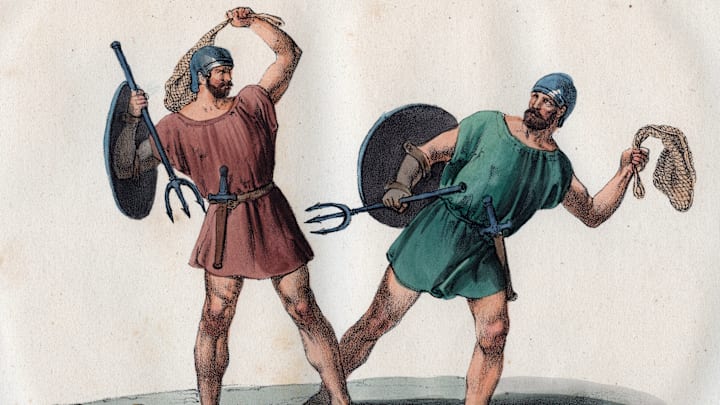Whether you were hoping to drop a few pounds or build that summer six-pack, the ancient world was loaded with helpful pointers about getting in shape.
1. Drunk athletes still have to exercise (just not as strenuously).
Intoxication wouldn’t excuse you from one of Philostratus’s fitness lessons. The Greco-Roman gymnastics guru realized that people couldn’t train as effectively while under the influence. Nevertheless, he maintained that tipsy pupils should still complete their regularly scheduled workouts, just with a bit less intensity than usual.
2. Nothing builds endurance like lifting boiling-hot cauldrons.

As its name suggests, the ancient Chinese sport of cauldron-lifting involved picking up metal pots filled with burning coal. Participants held these high above their heads in a painful test of human willpower. This spectacle occasionally turned deadly: King Wu of the Qin Dynasty broke his kneecap during one such contest and died a few months later.
3. Don’t over-train.
The Indian Caraka Saṃhitā is one of the world’s oldest medical documents (though historians don’t know exactly when it was created). While this text praises the many benefits of physical activity, it also calls for moderation: “Physical exercise in excess causes exertion, exhaustion, consumption, thirst, bleeding from different parts of the body, [shortness of breath], cough, fever, and vomiting.”
4. Ease up on the barley.

Denouncing high-carb diets is nothing new; many Roman gladiators bulked up by consuming a dense barley porridge loaded with beans. Claudius Galen—a celebrated Roman physician—believed this made them too flabby for serious combat and criticized the practice.
5. Your pre-workout routine should include lots of body oil.
Ancient Greek sportsmen were known to lather themselves in natural oils before exercising, which gave their bods a distinctive glisten. At the time, scholars claimed that doing so kept athletes from getting cold while toughening their skin.
6. Run through sand for extra stamina.
Anacharsis, a Mediterranean philosopher who spent much of his time traveling through Athens during the 6th century BCE, once wrote a detailed description of how the Greeks trained their sprinters. “The [practice] running is not done on hard, resistant ground,” he noted, “but in deep sand where it is not easy to plant a foot solidly or get a grip with it since it slips away from underneath the foot.” As an added bonus, these young men were also instructed “to jump over a ditch, if necessary, or some other obstacle carrying lead weights that are as large as they can hold.”
7. Flexibility is critical.

Taking yoga classes? Here’s one pose that might sound familiar: the 2000-year-old Egyptian painting above depicts a limber citizen bending over backwards until her hands touch the ground behind him.
8. Focus on controlling your breath.
During the 2nd and early 3rd centuries CE, China harbored a medical pioneer arguably on par with Hippocrates. Hua Tuo always preached the gospel of regular exercise; as he put it, “the human body requires exertion.” Tuo also knew that proper breathing played a vital role in personal well-being—so he designed a special stretch known as “Tiger Pawing” to help expand the lungs and improve respiration.
9. Wanna get toned? Try digging.
If your goal is to build chiseled, well-defined muscles without using techniques that involve “violent movement,” the aforementioned Galen recommended digging, rope-climbing, and extending the arms while a workout buddy tries pulling them downwards.
10. Pick short and simple exercises.

Seneca the Younger would’ve been a terrible phys ed teacher. The Roman philosopher believed that strenuous exercise was, ultimately, pointless. However, if somebody absolutely had to work out, Seneca favored keeping it quick. “There are short and simple exercises which will tire the body without undue delay,” he conceded, “[such as] running, swinging weights about, and jumping—either high jumping or low jumping … But whatever you do, return from body to mind very soon.”
11. Nobody likes a noisy weightlifter.
Say what you will about Seneca, but at least one of his fitness observations was spot-on. The following rant—inspired by an especially obnoxious breed of bodybuilder which frequented Rome’s urban bath-houses—might as well have been written about a present-day gym:
Conjure up in your imagination all the sounds that make one hate one’s ears. I hear the grunts of musclemen exercising and jerking those heavy weights around; they are working hard, or pretending to. I hear the sharp hissing when they release their pent breath.
And the bellyaching didn’t stop there. “Add to this,” Seneca moaned, “the racket of a cocky bastard, a thief caught in the act, and a fellow who likes the sound of his own voice … plus those who plunge into the pool with a huge splash of water.”
BONUS: Livestock can be used as makeshift dumbbells.

Just how badass was Milo of Croton? During his childhood (or so goes one legend), the future Olympian wrestler owned a young calf he used to lift onto his shoulders and carry around for a spell. Milo is said to have done this every single day: as it got bigger, he grew stronger. Four years later, Milo could be seen wandering around with a fully grown pet bull resting on his manly shoulders.
A version of this story ran in 2014; it has been updated for 2022.
